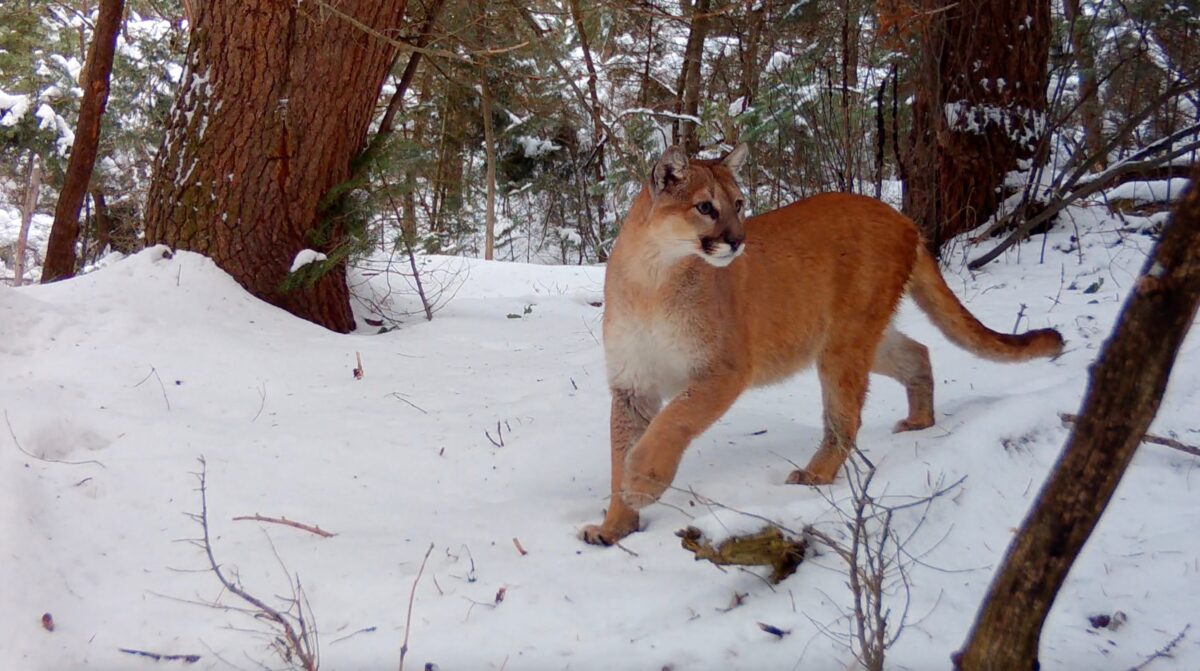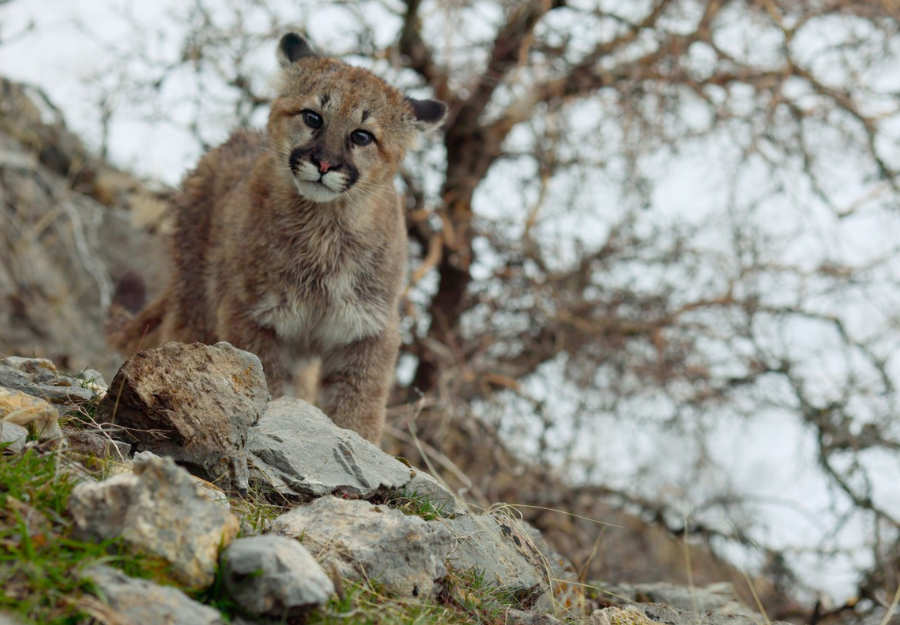ON AIR: Richard Gilbreth on his work at the International Exotic Animal Sanctuary
An Audio Interview with Julie West, MLF Broadcaster
 Listen Now!
Listen Now!
Listen to the interview from MLF’s ON AIR program, podcasting research and policy discussions about the issues that face the American lion.
Transcript of Interview
Julie: My name is Julie West. I’m here with the director of the International Exotic Animal Sanctuary, Richard Gilbreth. This is somewhat of a unique conversation today because I’m actually here at the sanctuary outside Boyd, Texas, and had the benefit of touring the grounds a little moment ago. I’m going to be speaking with Richard about some of the challenges and rewards he faces being a director of a unique sanctuary like this. Richard, how long have you been the director?
Richard: Since 1996.
Julie: Since 1996. And what prompted you into this particular line of work?
Richard: Well, I’ve always worked with animals all my life. I’m an animal science major. I graduated from Charlton State University. I was an Ag [agriculture] teacher for a while. I’ve worked with the game and fish departments in New Mexico and Colorado on problem bears and stuff back in the seventies, and I’ve done a lot of artificial inseminating with cattle in Louisiana back in the eighties, so I’ve dealt with animals of some sort all my life.
Julie: Now this sanctuary is not a rehabilitation sanctuary. It’s, as you spoke with me on the phone yesterday, really kind of a last stop for many of these animals. Talk about that a little bit.
Richard: This is the last hope that some of these animals had, was us taking them. A couple of the animals, I got emails that said “If you can’t take them, they’re going to be euthanized in five hours,” and that kind of stuff. So we’re the last hope that some of these animals have. Most all of our animals have been seized from individuals that could no longer care for them, or they didn’t have any business caring for them, or they didn’t have the proper permits and licenses, and they were seized by the U.S.D.A, U.S. Fish and Wildlife. We’ve got a number of animals here that were seized by the D.E.A. So all of our animals didn’t come from what you’d consider a great background.
Julie: Many of them traumatized, raised as pets, and gambled, I’m sure the –
Richard: When we get these animals, they have all sorts of problems, not only emotionally, but physically. We’ve had a lot of cats that come here that are de-clawed, that their teeth have been pulled so that people could play with them. Emotionally – we’ve had cats that have came here that have been in small enclosures, and when I say small enclosures, I’m talking about four by four by eight for fourteen years, stuff like that. So not only do these cats have physical problems, they’ve got an enormous amount of emotional problems. We’re a little bit different than most facilities that you’ll ever run into. Most places figure they need shelter, food, and some type of behavioral enrichment. We fill in the fourth one, which is emotional enrichment. We believe that all of these animals have emotions just like you and I do. Now, some of these big cats, yes, the only emotion they have that we don’t have is they don’t have any inhibitions about killing you. But far as liking you, disliking you, having a good day, bad day; they’re all the same. They fall right in with us.
Julie: Well, how many cats do you have?
Richard: Right now we have fifty-two cats.
Julie: Fifty-two cats. And I know that the sanctuary is not limited to cats, but for our purposes, we’re going to focus on the cats today. How many mountain lions do you have?
Richard: Right now we only have two.
Julie: Ok. Can you tell us a little bit about those mountain lions and their backgrounds? How long have they been here?
Richard: B.B has been here going on seventeen years. He’s a male mountain lion. Why he’s named B.B., I don’t know. That’s what he was named when I came. B.B. was found in a trailer house in Plano, Texas, with a tiger, and he lived next to that tiger all his life. Then we have N’dito, which is a female mountain lion that was brought here sixteen years ago as a baby. Some idiot had purchased her and then couldn’t care for her, so she ended up here. You have to remember, mountain lions in Texas are considered predators. So if they didn’t have a place like this to go to, they would have been put to death.
Julie: I see.
Richard: And I say “death” instead of “euthanize” because I want to stress the point.
Julie: You have a good reputation as a sanctuary nationally, and I understand the American Association of Zoos has actually recognized the work you do. Why don’t you talk a little bit about that process? Is it called accreditation?
Richard: We’re certified. When I first got here years ago, we looked for something to set us aside from other sanctuaries. The word “sanctuary” is probably one of the most abused words in the English language, in my opinion. People say they have sanctuaries but they also do breeding, they also do photos, they also do picture taking. They let people touch them, and they let them play with them. We don’t do any of that. This is the cat’s home, and we treat it as such. We honor their wishes. If they’re having a bad day, we work around them, although, most of the animals now they enjoy our company. They enjoy us working around them. They lay up there and watch us, and bask in the sun, and really enjoy it. That’s the reason we tried to get into the A.Z.A. No sanctuary had ever gotten certified or accredited by the A.Z.A. ever.
Julie: No Kidding.
Richard: We were the first, and we’re the still the only one that’s ever made it.
Julie: So what happens in that process? They visit your grounds and observe what you do? Tell us a little bit about that.
Richard: When you first start you get an application, and it took me three months to complete this application. You have to have protocols for everything from escapes, to natural disasters, to blood, to quarantine procedures; everything in the world that you can imagine. You have to have some type of procedure on file and approved by them. Once you get all of that done, you’re inspected by a group of inspectors from the A.Z.A., and they write their recommendations. They also may have what they consider, what they call, their “concerns.” They give you an amount of time to correct the concerns if you have some concerns. We were lucky. I think we had three concerns when we did this. They inspect you every five years to renew your certification and accreditation. Then you have to go before an accreditation board; fifteen people that are directors from other zoos across the United States, and they “yea” or “nay” you. The first time we were tabled.
Julie: And what does that mean?
Richard: They didn’t know what to do with us. We’re not a zoo.
Julie: Oh. Because you were the first sanctuary!?
Richard: That’s right. We were not a zoo, and they did not know where to put us. So basically what they have ended up doing is they have put us under what they consider “related facilities.” The only thing that is different between a related facility and a zoo accreditation: they certify us. What that means was we don’t open our doors to the public where they can roam freely throughout the park. After you’ve been on the tour, you could see why you couldn’t allow people to just roam freely here. Plus, if you go to zoos, you see people whistling at the animals, throwing popcorn, throwing rocks, beating on the glass – doing something to make the animals move. They’re exhibits there. They’re not an animal; they’re exhibits. And here, this is their place. We’re non-profit, and it’s theirs. It don’t belong to anybody else other than the animals that are here.
Julie: Did you find that the certification enabled you for a certain level of funding that maybe you didn’t have access to before or has that made a difference at all in the support you get?
Richard: No. The funding has not made any difference to us. As a matter of fact, it hasn’t done what I had hoped. It did set us apart from a lot of other sanctuaries, so-called sanctuaries, across the United States. And it’s allowed us to be recognized by the U.S. Fish and Wildlife, and we get more calls from them to help them. It also allows us to train individuals, interns here, that get A.Z.A experience. They have to get it at an A.Z.A facility, and we have a large educational program for college students who’ve got out of college, where they can move on to zoos and other animal facilities and get jobs
Julie: Yes, and I met some of your interns earlier today. So how many at a time do you take?
Richard: We take eight at a time on a three month deal. We do a quarter. And we also have a six-month intern program. Last time we had eight, and six of those eight got jobs and are working right now.
Julie: Very good. Do you have a vet here on the grounds or a relationship with an animal hospital?
Richard: I don’t have a vet on grounds. I have a vet on call. He lives one mile from us, and we’re really lucky to have Dr. Moore. His wife is also a vet. Both of them have treated an enormous amount of exotic animals in their lifetime. Plus, we have another vet to the south of us here that also treats tigers; that is very familiar with tigers and big cats. Between those two vets, they have probably treated more big cats than any other vet in this country right now.
Julie: Very good, very good.
Richard: We get a vet tech from his office once a week that comes out, visually inspects all the cats, goes through all of our data that we catch, or that we take, everyday: what we feed, visual, what type of medication the vet’s got them on. We administer that medication ourselves. If it’s something as far as a dart or a shot or something, he handles that or the vet tech does.
Julie: Given your reputation, do you sometimes get animals from zoos? Do zoos ever give you aging animals or call you?
Richard: I get calls sometimes. But my questions with zoos are “Are you going to help us? We’re going to take this exhibit that you have made hundreds of thousands of dollars from, and it’s just got old, and it’s no longer a good exhibit. You’ve got to help us take care of it for the rest of its life.”
Julie: Fair enough, and does that happen?
Richard: Very few times, but it has. I’ve had a couple that’s offered us a thousand dollars to take a tiger that’s going to live another ten years. Right now our tigers are costing us – our over-head on one tiger is about six-hundred dollars a month.
Julie: Wow.
Richard: Now that includes insurance, electricity, food, medicine, maintenance on their habitats, all of it. It’s all overhead, all rolled into one. But most zoos will not send money along to help their animal.
Julie: So you rely on private donations?
Richard: Yes. Oh, yes. We don’t get any help from the government, from the state. All of our funds come from private individuals that are caring. We also write probably five-hundred grants a year. We do in-kind goods. I know we’re not talking about bears right now, but we do get meat from a store. We have a WalMart in Fort Worth that’s donating us stuff that’s going to be out-dated in a day, and we go pick it up. And we’re getting probably anywhere between five and six-hundred pounds of meat every Monday and probably four or five-thousand pounds of produce.
Julie: Wow! Good.
Richard: So we do a little bit of everything to make all of this work
Julie: Let’s jump back for a minute. I guess I have two questions, but one is you talked about the emotional as well as physical well being of the animal, and I know you have an animal behaviorist, don’t you?
Richard: That’s right. Yes.
Julie: So tell me a little bit about that person’s role with the cats
Richard: This individual has been working with animals for over forty years. If you go back and look, the A.Z.A never required any facility to have a behaviorist on staff until 2006.
Julie: Why?
Richard: They didn’t figure it was important. You have to remember, you start saying these animals have emotions and they have feelings, you’re treading in a very ripply area. Because if you get into some of that part, then you get involved with some of your other organizations like PETA and all that. So you have to tread very lightly, because they didn’t really want people to think that animals had emotions, had feelings, and had all of this. Like operative conditioning and stuff. We’ve been doing operative conditioning here and emotional enrichment for as long as I’ve been here – since ’95.
Julie: So tell me what does that mean? How does that translate in a day-to-day, typical interaction with some of the cats?
Richard: Well – like emotional enrichment – you’ll notice when we go out and feed, they’ll come right up to us, to the edge of the pen. They’ll jump up on their perch and let me look at them and inspect them. They’ll chuff, rub their heads up against the fence, turn around and lay down. I’ve been able to go as far as to give a big lion down here a transfusion without sedation. I’ve never sedated any animal on this park to move them. Ever.
Julie: So there’s some trust there.
Richard: There’s a lot of trust. I respect them, and they respect me. It’s really unique that the animals can know the difference between me, the girls that feed them, the keepers, and the behaviorist. Over the years we put forth this behavioral program to the A.Z.A. back in 2001. And basically, they looked at it as if this person were just playing with a pet. That’s how they sensed it, that’s the way they reacted to it. It’s took a long time — well, it’s not really long, it’s ten years and that’s a while — for them to realize that some of the stuff that we are doing here has been really on the cutting edge of becoming connected with these animals in different ways that they’ve never seen.
Julie: I’m very interested in that. If you read about Jane Goodall and her work with the chimps, that was considered to be incredibly unconventional. People pooh-poohed her, they thought she was crazy, and here she’s really forged the way for many other behaviorists. So why not the Jane Goodall of cats?
Richard: Yeah. There’s lots of things that we have done. I’ve had a cat here that got a bone stuck on its tooth, one of its big canines. This big lion allowed the behaviorist to get a hold of it and pull it off, or we would have had to sedate him. There is a mutual trust with these animals. Now, okay, you have to remember these are animals, and there are some animals that still won’t trust you. It’s no different; it’s just like people. Some people will trust you to a certain point and then they won’t trust you. These animals are basically the same way. Our behaviorist, with new animals that come in, he works with them to get them to a point to allow us to work around them, because we are going to have to take care of them for twenty years. Wouldn’t it make sense for this animal to be comfortable with our presence while we are doing what we need to do to give them a quality of life for the next twenty years? That’s one of our major points is we work on that.
Julie: I notice there are a lot of toys for the cats, and so they must get a lot of enjoyment with their tires and water pools.
Richard: Oh they love their tires. Some of these big cats love — they think the tire is like a pacifier for a little kid. And all the big cats have pools, because they love water. I don’t know if you noticed but we have a mister system that’s all over this whole area down here. It’s got about ten mister tips for each enclosure which, you know, being 30 [degrees] today it’s not on. It’s in the summertime.
Julie: But on a hot Texas day… [laughing].
Richard: On a hot Texas day it’s on, and it’s working. And they know exactly where the mister tips are, and that’s where they’re at. They’re laying there.
Julie: [Laugh] They’re standing under the mister tips. I want to get back to another point. You had said that some times you are consulted by game and fish folks. Does that mean they might find an orphaned mountain lion cub or some other…
Richard: Normally, on the mountain lion cubs and stuff, that is pretty rare. In all the years I’ve been doing this, there’s one, of the mountain lions. The bears – I get calls during the spring-springtime, on bears constantly, because their moms are getting killed. They’re getting run over by cars – the cars on the highways – and everything. As far as the big cats, the tigers and the lions, I get – most of all of my calls from the U.S.D.A, and the U.S Fish and Wildlife, and the Game and Fish Department are big animals, because they don’t find them until people are having problems with them. As long as they’re babies, most people never see them. They’re hid. But once you get a tiger that’s weighting two and three hundred pounds, it’s hard to keep him in the house.
Julie: No kidding.
Richard: So those, by the time I hear about it from the Game and Fish or some legal entity, they’re usually one year old or older.
Julie: When we spoke briefly on the phone the other day, you surprised me by saying that there’s a resurgence of mountain lions in North Texas. Tell me a little bit about that.
Richard: Well, I grew up in North Texas, South Amarillo. Back in the sixties and seventies, there wasn’t any deer in that country. There were no turkeys; there were no deer; there wasn’t any wild hog. There wasn’t any of that. Basically the only animal that you seen in that country was bobwhite quail and rattlesnakes. About ten years ago, there was an influx of migrating deer from New Mexico, Colorado, and Okalahoma moving into North Texas along the Red River, along the Canadian, moving down towards this way. A lot of the reason for that was a lot of this land that was farmed once back in the sixties – fifties, sixties, and early seventies – was all put into C.R.P [Conservation Reserve Program]. That’s a government program where they pay the farmer not to farm it. They plant grass, and it goes back to just nature. The way it was a hundred years ago when the buffalo roamed here. Well these animals are all moving into this country now because they have places to hide; they have a natural type habitat that’s coming up again. And now, all the way down to Wichita Falls and Denton in here, we got wild, feral hogs. We got turkeys. We got mule deer. We got whitetail deer. And what is their predator? The mountain lion. It’s coming right behind. Because, you know, food. They’re going to follow the food.
Julie: So I wonder then with that change, if game management policies have changed in Texas.
Richard: Not in Texas, no. The mountain lion is still considered a predator. If you call the Texas Parks and Wildlife tomorrow and tell them you have a mountain lion out there that you saw that you’re afraid it may kill one of your horses or colts or something, they’ll just tell you “Well if you see it again, shoot it.” That’s it. That’s as far as they’re going. They are not going to open up that can of worms where they are going to start protecting it or managing the hunting part of it or any of it.
Julie: It just seems like if you’re encouraging the land to revert back to a natural prairie state, which then in turn will attract all these other animals, then you better be prepared for–
Richard: Well you have to remember, that’s the Game and Fish, and that’s some of their stuff. I’m sure that there’s someone working on mountain lion policy at this point. It’s something that we are not privy to at this time.
Julie: Well, you have beautiful grounds here.
Richard: Thank you.
Julie: Tell us how many acres you have total.
Richard: About forty acres
Julie: Forty acres.
Richard: I would love for you to be here in the spring, when everything is green and all the vines on the habitats are green and the flowers are blooming. That’s when it’s really pretty and all the animals are laying out on their perches, sunning and stuff. That’s when it’s really nice and enjoyable. But, you know, we have to go through winter, and everybody’s pretty much in their houses because it’s cool.
Julie: Well, I’ll be sure to visit in the spring.
Richard: Good!
Julie: Well, thank you for the service you provide these animals. That’s important work you and you’re team are doing.
Richard: I appreciate it, and they appreciate it. It’s something that I think is gratifying for all of us.
Julie: Take care.
Richard: Thank you.
Closing: [music] This has been a Mountain Lion Foundation On Air broadcast. On Air is a copyrighted production of the Mountain Lion Foundation. Permission to rebroadcast is granted for noncommercial use.





 Facebook
Facebook Twitter
Twitter Send Email
Send Email


